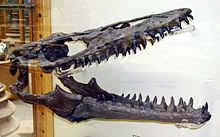Mosasaur
| Mosasaur Temporal range: Upper Cretaceous,
| |
|---|---|

| |
| Mounted skeleton of a plioplatecarpine (Plesioplatecarpus planifrons), Rocky Mountain Dinosaur Resource Center | |
| Scientific classification | |
| Domain: | Eukaryota |
| Kingdom: | Animalia |
| Phylum: | Chordata |
| Class: | Reptilia |
| Order: | Squamata |
| Clade: | Platynota |
| Superfamily: | †Mosasauroidea Gervais, 1853 |
| Subgroups | |
| |

Mosasaurs were large, predatory marine lizards of the Upper Cretaceous. The first fossil Mosasaur, Mosasaurus hoffmanni, was found in the Netherlands in 1776.[1]p7 It was named in 1822 by W.D. Conybeare.
For the last 20 million years of the Cretaceous period after the extinction of the ichthyosaurs and pliosaurs, mosasaurs became the dominant marine predators. They became extinct at the K-Pg event at the end of the Cretaceous period, about 66 million years ago.
Discovery and interpretation
[change | change source]The first specimen was found in a chalk quarry in Maastricht, Holland. It was found by a German army surgeon, Johann Hoffmann, who collected fossils for the Haarlem Museum. During a struggle for ownership, the skeletal parts went to the museum, whilst the skull stayed with the owner of the land, who refused to let anyone see it.
The true identity of the monster was explained by Georges Cuvier. In 1795 French troops were outside Maastricht, and Cuvier arranged for the large skull to be saved when they stormed the town.
Habitat
[change | change source]Thousands of fossils have been found, from every continent. There are about 40 known species. Most skeletons have been found in North America in chalk laid down in the Western Interior Seaway.[2]
An interesting fact is that ichthyosaurs had died out by the middle of the Upper Cretaceous, and plesiosaurs and sea-going crocodiles were in decline. The reasons for this are not known. It is this large marine predator niche that mosasaurs occupied. They flourished in the later Cretaceous, only to become extinct at the K/T extinction event.
Size
[change | change source]
The type species was estimated to be 33' (10m) long. Mosasaurus had four paddle-like limbs on a long, streamlined body and a long, powerful tail. The large head had huge jaws, up to 4 ft (1.2 m long) with many teeth. The jaws could open about 3 feet (1 m). The lower jaw is loosely hinged to the skull with a moveable joint on each side (behind the teeth). This loose joint let it swallow huge prey. They would have hunted fish, turtles, molluscs, and shellfish. Ammonites have been found bearing mosasaur teeth marks.
The smallest-known mosasaur was Carinodens belgicus, which was about 3.0 metres (9.8 ft) to 3.5 metres (11 ft) long and probably lived in shallow waters near shore, cracking molluscs and sea urchins with its bulbous teeth. Larger mosasaurs were more typical: mosasaurs ranged in size up to 17 metres (56 ft). Hainosaurus holds the record for longest mosasaur, at 17.5 metres (57 ft).
The large size of mosasaurs, like whales, meant they were more likely to be warm-blooded than cold-blooded.[3][4]
Other genera
[change | change source]Many other genera of mosasaur have since been found, for example, Tylosaurus. Mosasaurus maximus was found at Onion Creek, Texas. All have the same general body style and pattern of life, though some, like Prognathodon, had crushing teeth for dealing with shellfish. Present thought is that their closest living relatives are the monitor lizards.[5]
References
[change | change source]- ↑ Benton M. 1990. The reign of the reptiles. Crescent, N.Y.
- ↑ Michael J. Everhart 2005. Chapter 9: Enter the Mosasaurs, in Oceans of Kansas: a natural history of the western interior sea. Bloomington: Indiana University Press. ISBN 0-253-34547-2
- ↑ University of Plymouth (May 26, 2020). "Scientists reveal new fundamental principles governing diving in animals" (Press release). Eurekalert.org. Retrieved June 1, 2020.
- ↑ Wilco C. E. P. Verberk; Piero Calosi; François Brischoux; John I. Spicer; Theodore Garland; David T. Bilton (May 27, 2020). "Universal metabolic constraints shape the evolutionary ecology of diving in animals". Proceedings of the Royal Society B: Biological Sciences. 287 (1927). Proceedings of the Royal Society B. doi:10.1098/rspb.2020.0488. PMC 7287373. PMID 32453989.
- ↑ Bell G.L. Jr and Polcyn M.J. Dallasaurus turneri, a new primitive mosasauroid from the Middle Turonian of Texas and comments on the phylogeny of Mosasauridae (Squamata). Netherlands Journal of Geosciences — Geologie en Mijnbouw 84: 177-194.
